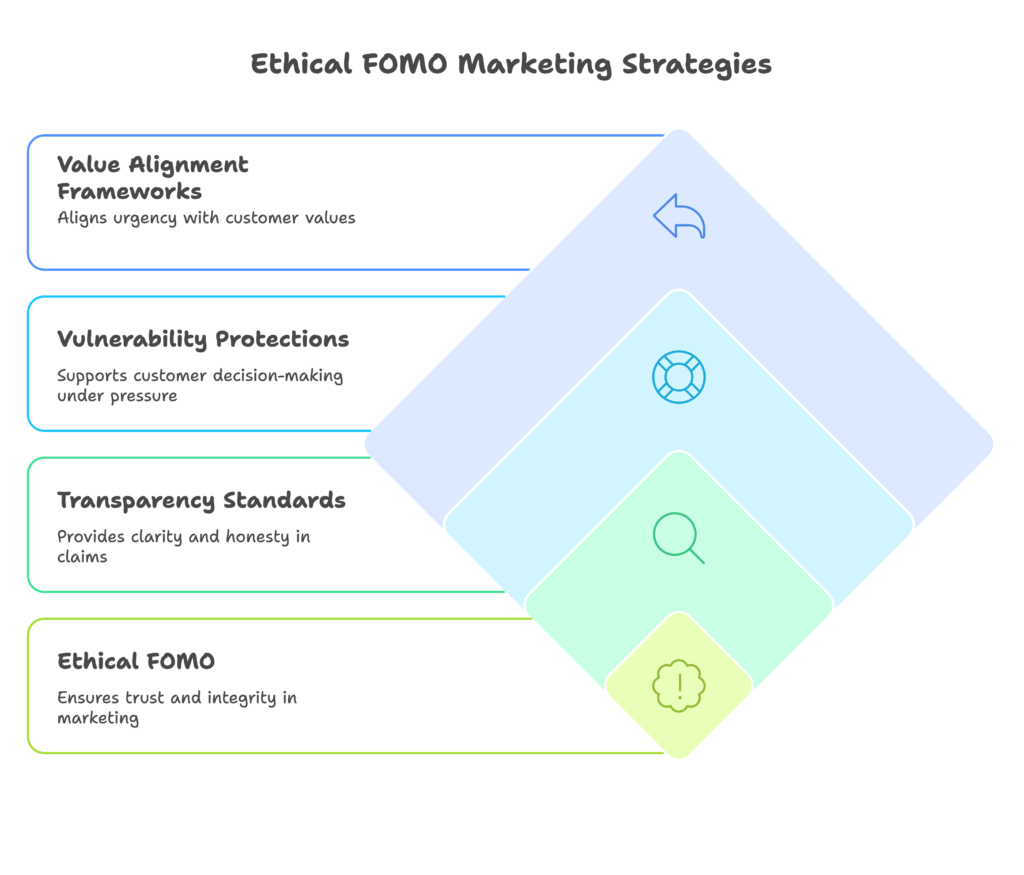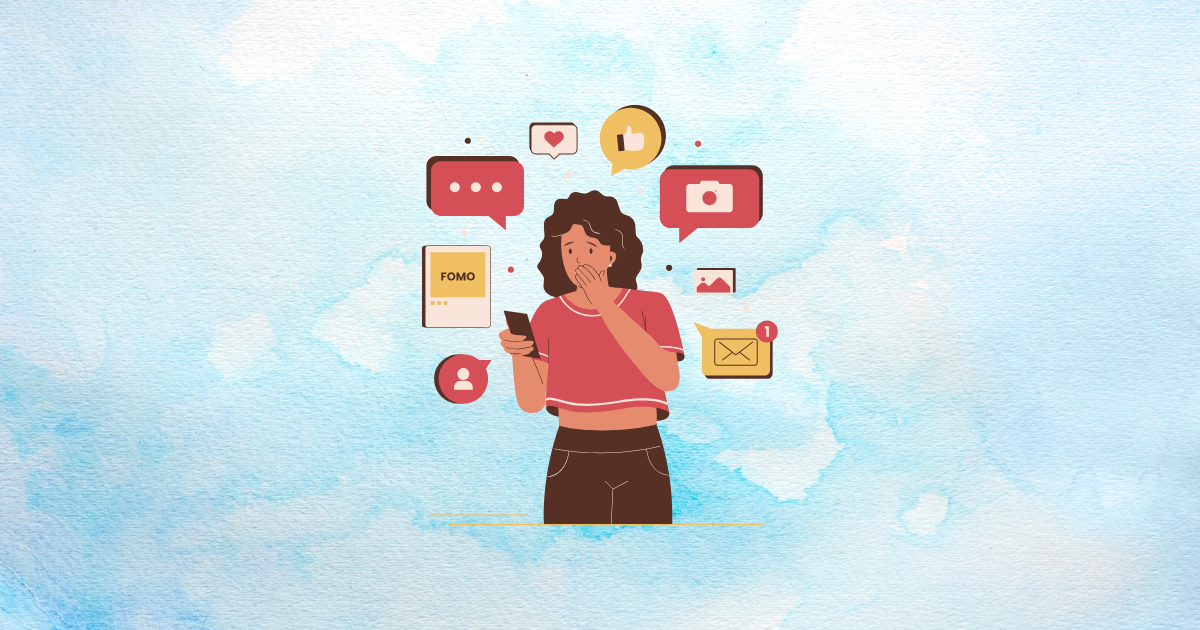Have you ever found yourself frantically clicking “Buy Now” on a limited-time offer, even though you weren’t entirely sure you needed the product? Or maybe you’ve stayed up late to catch a “one-night-only” online event, despite having an early morning the next day? That feeling of urgency and anxiety about missing out is exactly what marketers aim to create with FOMO (Fear Of Missing Out) tactics.
But here’s the million-dollar question: How can businesses create that powerful sense of urgency without making customers feel manipulated or tricked? In today’s savvy consumer landscape, the line between effective FOMO and alienating your audience has never been thinner.
By reading this article, you’ll discover:
- The brain science behind effective FOMO marketing
- Ethical guardrails that keep your customers trusting you
- Practical techniques that create genuine urgency
- Real-world examples from brands who do it right
- Future trends that will shape how FOMO evolves
Ready to master the art of creating desire without the icky aftertaste? Let’s dive in!
Psychological Foundations of Ethical FOMO
Before we jump into tactics and strategies, let’s understand what’s actually happening in your customers’ brains when they experience FOMO. This knowledge forms the foundation for creating urgency that feels natural rather than manipulative.
Neurocognitive Mechanisms
When we encounter something scarce or time-limited, our brains light up in fascinating ways:
Amygdala Activation Patterns During Perceived Scarcity
The amygdala—your brain’s emotional processing center—activates when you perceive something might be in short supply. This creates that familiar flutter of anxiety that something valuable might slip through your fingers. The key insight? This response happens automatically before our rational brain has a chance to weigh in.
Dopamine Release in Reward Anticipation
When we see something we want, our brain’s striatal system releases dopamine—not just when we get the thing, but when we anticipate getting it. This means the excitement of clicking “Buy” on a limited offer can be more rewarding than actually owning the product! Ethical FOMO taps into this natural desire without over-hyping what the product will deliver.
Prefrontal Cortex Engagement in Ethical Decision-Making
The prefrontal cortex handles our rational decision-making. When FOMO marketing gives people enough time and information to engage this part of their brain—even briefly—they’re more likely to feel good about their purchase afterward rather than experiencing buyer’s remorse.
Behavioral Economics Framework
Beyond brain chemistry, certain economic principles explain why FOMO works so powerfully:
Loss Aversion vs. Gain Framing Balance
Studies consistently show that people feel the pain of losing something twice as intensely as the pleasure of gaining something equivalent. This “loss aversion” is why “Last chance!” messages often outperform “Great opportunity!” messages. But ethical FOMO balances these approaches, highlighting both what might be missed and what will be gained.
Social Proof Thresholds for Authenticity
Seeing others want or enjoy something makes us more likely to want it too. However, today’s consumers have developed a “social proof threshold”—they can spot fake or exaggerated popularity claims. Ethical FOMO uses real, verifiable social signals that build trust rather than triggering skepticism.
Temporal Discounting in Urgency Creation
People naturally value immediate rewards over future ones—a principle called “temporal discounting.” This is why countdown timers work so effectively. The ethical approach? Ensure your urgency triggers are tied to genuine limits (like production capacity) rather than artificial scarcity.
Cultural Perception Variations
Not everyone experiences FOMO the same way—cultural and demographic factors play a huge role:
Individualist vs. Collectivist FOMO Responses
In individualistic cultures (like the US), FOMO often triggers around personal status or unique experiences. In collectivist cultures (like Japan), FOMO more commonly centers on group belonging and shared experiences. Ethical marketers adjust their messaging accordingly.
Generational Differences in Digital-Native Audiences
Gen Z and younger Millennials have grown up surrounded by urgency marketing. They’ve developed stronger “FOMO filters” and often respond better to authenticity and transparency than to artificial hype. Meanwhile, older generations might still be more susceptible to traditional scarcity messaging.
Cross-Platform Engagement Norms
FOMO triggers that work on Instagram might fall flat on LinkedIn. Each platform has its own unwritten rules about acceptable urgency. The ethical approach recognizes these differences rather than applying one-size-fits-all tactics.
Now that we understand the brain science and behavioral drivers behind FOMO, let’s explore where to draw the line between effective marketing and manipulation. After all, creating urgency only works long-term if your customers trust you!
Ethical Boundaries in FOMO Implementation
Building customer trust is a long game, while destroying it can happen in an instant. In this section, we’ll explore the guardrails that keep your FOMO marketing on the ethical side of the line.

Transparency Standards
When it comes to creating FOMO ethically, transparency isn’t just nice to have—it’s essential:
Authentic Scarcity Validation Protocols
If you claim something is limited, it should actually be limited. Ethical brands implement systems to validate scarcity claims, like displaying actual inventory counts, production capacity limits, or enrollment caps. The rule is simple: never fake scarcity when you have unlimited supply.
Countdown Timer Accuracy Requirements
Those ticking clocks on websites are powerful motivators, but they should reflect reality. Timers that reset for each visitor or mysteriously extend when they reach zero quickly erode trust. Ethical FOMO ensures timers are tied to actual deadlines, whether for flash sales, enrollment periods, or shipping cutoffs.
Inventory Disclosure Best Practices
When showing “only 3 left!” messages, ethical brands ensure these numbers reflect actual available inventory. Some transparency leaders even explain how their inventory systems work, helping customers understand why something might be scarce.
Vulnerability Protections
Not all customers are equally positioned to make level-headed decisions under pressure:
Cognitive Overload Prevention Systems
Decision fatigue is real. Ethical FOMO marketing avoids bombarding customers with multiple overlapping urgency triggers. Instead, it focuses on one clear reason to act now, giving the brain space to process the decision properly.
Financial Risk Awareness Triggers
For high-ticket purchases, ethical FOMO includes “cooling off” moments—brief pauses that encourage reflection before final commitment. This might include clear cancellation policies, payment plan information, or simple reminders to ensure the purchase fits within the customer’s budget.
Addiction Pattern Monitoring
Some customers are more vulnerable to compulsive purchasing than others. Ethical brands implement systems to identify potential addiction patterns, such as rapidly repeated purchases or unusual spending spikes, and may include self-regulation tools or gentle interventions.
Value Alignment Frameworks
FOMO works best when it aligns with what truly matters to your customers:
Product-Benefit Congruence Checks
The urgency you create should match the actual benefit of not delaying. For example, a limited-seat workshop that really will fill up warrants urgency. A digital product with unlimited supply probably doesn’t. Ethical FOMO ensures the “fear” matches the reality of what might be missed.
Brand Promise Consistency Audits
Your FOMO tactics should align with your overall brand values. A luxury brand promising thoughtful consumption shouldn’t use high-pressure sales tactics. A value brand shouldn’t create artificial exclusivity. When your urgency messaging contradicts your brand promise, customers notice—and not in a good way.
Social Responsibility Integration
Increasingly, ethical FOMO connects urgency to positive impact. Limited-edition products that support specific causes, time-bound matching donation periods, or exclusive access to purpose-driven communities all create urgency tied to values rather than just commercial gain.
With ethical guardrails in place, it’s time to explore specific techniques that create genuine urgency without crossing the line. Ready to see how the magic happens? Let’s take a closer look at strategies that create both desire and trust.
Strategic FOMO Creation Techniques
Now for the fun part! Let’s explore practical techniques that create that winning combination of urgency and trust. These approaches generate genuine FOMO while keeping customer relationships strong.

Authentic Scarcity Engineering
The most powerful FOMO comes from real limitations, not artificial ones:
Dynamic Inventory Display Systems
Today’s technology allows for real-time inventory visibility. When customers can see stock levels changing as others make purchases, it creates natural urgency without any hype needed. The key is ensuring these systems reflect actual inventory—nothing erodes trust faster than fake scarcity claims.
Production-Limited Collections
Rather than artificially limiting availability, consider building genuine constraints into your business model. Small-batch production, limited material availability, or artisanal creation processes create natural scarcity that customers can understand and respect.
Seasonal Availability Calendars
Nature provides perfect urgency cycles. Seasonal ingredients, weather-dependent experiences, or holiday-specific offerings create urgency based on real-world constraints. When openly communicated through availability calendars, these limitations feel fair rather than manipulative.
Social Proof Optimization
Seeing others interested in what you offer creates powerful FOMO:
Real-Time Purchase Notifications
Those little pop-ups showing “Sarah from Boston just purchased…” create immediate social proof. To keep these ethical, use actual recent purchases (not fabricated ones), anonymize enough details to protect privacy, and don’t overwhelm the shopping experience with too many notifications.
User-Generated Content Curation
Genuine customer photos, reviews, and stories create FOMO more effectively than polished marketing materials. Showcase real people enjoying your products or services, and the fear of missing out follows naturally. Bonus points for highlighting diverse customers that represent your full audience.
Community-Driven Waitlists
When demand exceeds supply, waitlists create natural urgency. Making these community-visible (showing position or list size) adds transparency while amplifying the sense that something valuable is in high demand. The ethical approach ensures fair waitlist processes rather than artificially manipulating the queue.
Temporal Urgency Design
Time limitations create powerful motivation when used honestly:
Event-Based Countdowns
Tying urgency to actual events—whether a product launch, enrollment deadline, or shipping cutoff—creates legitimate reasons to act now. The ethical approach ensures these deadlines are real and communicated clearly, with reasonable lead time for decision-making.
Progressive Discount Structures
Rather than false “last chance” discounts that mysteriously reappear, consider transparent progressive pricing. Early-bird rates that genuinely increase over time reward prompt action while still giving latecomers access (just at a different price point).
Renewal Reminder Systems
For subscription-based businesses, thoughtful renewal reminders create legitimate urgency while demonstrating respect for customers. The ethical approach gives adequate notice and clear information about what happens if no action is taken.
With these strategic techniques in your toolbox, it’s time to explore how they translate to specific platforms. Different channels require different approaches to create that perfect balance of urgency and trust. Curious about making FOMO work seamlessly across your digital ecosystem? Let’s find out!
Platform-Specific Implementation
FOMO doesn’t look the same everywhere. Let’s explore how to adapt these principles for different digital environments while maintaining that crucial ethical balance.
E-Commerce Product Pages
Your product pages are where purchase decisions happen—making them critical for ethical FOMO implementation:
Fold-Level Urgency Hierarchy
Position urgency elements strategically on the page, with the most important “above the fold” (visible without scrolling). The ethical approach prioritizes product information first, urgency signals second—never hiding key details below urgency triggers.
Mobile-Optimized Scarcity Displays
With most shopping happening on mobile devices, urgency elements must work well on small screens without overwhelming the experience. Consider how inventory counters, timers, and social proof indicators appear on mobile, ensuring they enhance rather than distract from the shopping experience.
AR/VR Try-Before-FOMO Triggers
Emerging technologies like augmented and virtual reality create new opportunities for ethical FOMO. Allowing customers to “try” products virtually before seeing limited availability information reduces post-purchase regret while maintaining urgency.
Email Marketing Sequences
Email remains one of the most effective channels for creating timely urgency:
Abandoned Cart Escalation Tiers
Rather than immediate high-pressure tactics, ethical abandoned cart emails start gentle and increase urgency gradually. Early reminders focus on helpful information, while later messages might introduce legitimate time constraints like inventory limitations.
Loyalty Pre-Access Announcements
Giving loyal customers early access to new or limited products creates positive FOMO that rewards relationship-building. The ethical approach ensures these early access periods are meaningful, not just token 15-minute head starts.
Replenishment Reminder Flows
For consumable products, helpful reminders when it’s time to restock create service-oriented urgency. The ethical approach bases these on actual usage patterns rather than arbitrary timeframes, and includes genuine information about stock limitations if relevant.
Social Media Integration
Social platforms are natural FOMO amplifiers when used thoughtfully:
Story-Based Ephemeral Offers
The temporary nature of Stories on platforms like Instagram creates natural urgency. Ethical brands ensure these limited-time offers remain visible long enough for reasonable decision-making, and that the offers themselves deliver real value.
Live-Shopping Urgency Cues
Live shopping events create natural time constraints. The ethical approach ensures products shown are actually available (not “gotcha” out-of-stock situations), and that pressure tactics don’t replace product education.
Algorithmic Social Proof Amplification
Social platforms naturally highlight popular content. Working with rather than against these algorithms, ethical brands create genuine engagement that triggers FOMO organically, rather than using manipulation tactics like false engagement or misleading previews.
Now that we’ve covered implementation across platforms, a critical question remains: How do you know if your FOMO marketing is both effective and ethical? Let’s explore the measurement approaches that help you strike that perfect balance.
Measurement & Optimization
What gets measured gets managed—and that’s especially true for ethical FOMO marketing. Let’s explore how to track not just conversions, but the quality of customer experiences with your urgency tactics.
Ethical Metrics Tracking
Beyond standard conversion rates, these metrics help ensure your FOMO marketing builds relationships, not just transactions:
Purchase Regret Rate Monitoring
Track returns, cancellations, and customer service inquiries that indicate buyer’s remorse. Look for patterns related to specific FOMO tactics, and be willing to adjust or remove approaches that consistently lead to post-purchase regret.
Trust Metric Correlation Analysis
Compare Net Promoter Scores (NPS) or other trust measurements against exposure to different urgency tactics. The goal is identifying which FOMO approaches enhance perceived trustworthiness versus those that might damage it, even if they drive short-term sales.
Long-Term LTV vs. Impulse Buy Ratios
Examine whether customers acquired through different FOMO tactics become loyal repeat buyers or one-time purchasers. Ethical urgency should drive valuable long-term relationships, not just momentary impulse purchases.
Neurometric Validation
Advanced measurement approaches can provide deeper insights into emotional responses:
EEG Emotional Engagement Scoring
For larger brands, electroencephalogram (EEG) testing can measure brain activity during exposure to different FOMO tactics. This helps identify which approaches create positive engagement versus anxiety or frustration.
Eye-Tracking Fixation Duration Analysis
Eye-tracking studies reveal which urgency elements receive attention and which get ignored or create confusion. This helps optimize placement and design for clarity rather than manipulation.
Facial Coding Micro-Expression Mapping
Analyzing subtle facial expressions during user testing helps identify emotional responses to different urgency tactics. The goal is creating FOMO that generates positive anticipation rather than negative stress reactions.
Continuous Improvement
Ethical FOMO marketing evolves based on customer response and changing expectations:
Churn Prediction Models
Develop systems to identify when FOMO tactics might be pushing too hard, potentially driving customers away. Early warning signs might include decreased email engagement, reduced site visit frequency, or social media unfollow patterns.
Ethical A/B Testing Frameworks
When testing different urgency approaches, include ethical metrics alongside conversion rates. The winning variation should excel at both driving action and maintaining trust, not just maximizing immediate sales.
Cultural Adaptation Algorithms
Different audience segments respond differently to urgency. Develop systems to recognize these variations and adapt FOMO tactics accordingly, respecting cultural, generational, and individual differences in how urgency is perceived.
Talking about measurement is important, but there’s nothing like seeing ethical FOMO in action. Let’s explore some real-world examples of brands that have masterfully balanced urgency and trust. These case studies might surprise you—sometimes the most effective FOMO doesn’t look like FOMO at all!
Case Studies in Balanced FOMO
Sometimes the best way to understand ethical FOMO is to see it in action. These brands have found unique ways to create desire without manipulation.
Patagonia’s “Buy Less” Campaign
Counterintuitively, Patagonia’s famous “Don’t Buy This Jacket” campaign created powerful FOMO by challenging consumption itself:
Anti-FOMO Messaging Driving 40% Revenue Growth
By encouraging customers to repair rather than replace and to buy only what they truly need, Patagonia created scarcity of identity—the feeling that by not buying thoughtlessly, customers joined an exclusive group of conscious consumers. This “reverse FOMO” approach led to 40% revenue growth in the year following the campaign.
Quality Longevity Emphasis Reducing Returns
Patagonia’s Worn Wear program, which celebrates and resells well-used gear, creates FOMO around product longevity rather than newness. This approach reduced return rates by 25% as customers began seeing their purchases as long-term investments rather than impulse buys.
Glossier’s Community-Driven Drops
Beauty brand Glossier has mastered community-centric urgency:
User-Voted Product Releases
By allowing their community to vote on which discontinued products to bring back in limited “drops,” Glossier creates genuine scarcity while giving customers agency in the process. This approach has resulted in 80% of limited items selling out within 48 hours, with unusually low return rates.
Transparent Production Timelines
Rather than creating mystery around availability, Glossier openly shares production constraints and timelines. Their “Coming Soon” pages include behind-the-scenes glimpses of product development, building anticipation while setting realistic expectations about availability.
REI’s #OptOutside Strategy
Outdoor retailer REI turned FOMO on its head with a bold Black Friday approach:
Black Friday Closure Increasing YOY Sales
By closing stores on Black Friday and encouraging customers to spend time outdoors instead of shopping, REI created powerful identity-based FOMO. Counterintuitively, this led to a 6% year-over-year sales increase as customers rushed to shop before and after the closure, while feeling aligned with the brand’s values.
Co-Created Content Amplifying Engagement
REI’s invitation for customers to share their #OptOutside experiences generated over 1.4 million social media posts in the first year. This user-generated content created natural social proof and FOMO around joining the movement, driving both engagement and sales without traditional urgency tactics.
These innovative approaches show that ethical FOMO often looks very different from traditional urgency marketing. But what’s coming next in this rapidly evolving field? Let’s peek into the future of creating desire without alienation.
Future of Ethical FOMO Marketing
The landscape of urgency marketing continues to evolve. Here’s what’s on the horizon for brands committed to ethical FOMO.
Emerging Technologies
New tools are creating fresh opportunities for transparent urgency:
Blockchain-Verified Scarcity Certificates
Blockchain technology allows for verifiable proof of limited quantities or unique items. Digital certificates attached to products can confirm their scarcity status, building trust in FOMO-generating claims about limited availability or exclusive access.
AI-Powered Personalization Guardrails
Artificial intelligence is increasingly being used to identify when FOMO tactics might be inappropriate for specific customers. These systems can recognize vulnerability signals and adjust urgency levels accordingly, creating more ethical personalization.
Biometric Consent Management
As biometric feedback becomes more accessible (through smartwatches and phones), innovative brands are exploring consent systems that adjust urgency based on detected stress levels. This creates a more humane approach to FOMO that respects individual emotional states.
Regulatory Evolution
The legal landscape around urgency marketing is changing rapidly:
Global FOMO Marketing Standards
Industry groups and regulators are beginning to develop specific guidelines for ethical urgency creation. Forward-thinking brands are participating in these discussions, helping shape standards that protect consumers while allowing for legitimate urgency tactics.
Neurometric Data Privacy Laws
As measurement of emotional and neurological responses becomes more common, new privacy regulations are emerging to protect this sensitive data. Ethical brands are developing transparent approaches to neurometric testing that respect these emerging boundaries.
Algorithmic Transparency Mandates
Regulations increasingly require disclosure of how recommendation and targeting algorithms work, including those that leverage FOMO. Brands embracing algorithmic transparency are building trust while complying with these emerging requirements.
Cultural Shifts
Consumer attitudes toward urgency continue to evolve:
FOMO Fatigue Counter-Strategies
As consumers grow weary of constant urgency, some brands are creating “FOMO-free zones” or “no-rush guarantees” as differentiators. This counter-positioning can actually generate its own form of FOMO among stress-conscious consumers seeking more mindful consumption experiences.
Value-Based Urgency Engineering
Rather than focusing on product scarcity, forward-thinking brands are creating urgency around values-aligned actions—limited opportunities to make positive impact, join purpose-driven communities, or participate in meaningful experiences.
Digital Wellbeing Integrations
As digital wellness becomes a greater priority, innovative brands are integrating wellbeing features alongside urgency elements—like purchase reflection tools, budget guardrails, or intentional friction that ensures mindful rather than impulsive decision-making.
Creating effective FOMO without alienating your audience isn’t just an ethical choice—it’s a business imperative in a world where consumer trust is the ultimate scarcity. By balancing genuine urgency with respect for your customers’ agency and wellbeing, you build relationships that last far beyond any limited-time offer.
Quick Tip: Ready to implement ethical FOMO in your own Shopify store? The Growth Suite app offers built-in tools for creating transparent urgency, from inventory counters to honest countdown timers—all designed with both conversion and trust in mind. Try it today to boost sales while building stronger customer relationships!
References
- IconicWP. (2025). Ethical FOMO Marketing
- LinkedIn. (2024). Ethical LLM Use in FOMO
- TrustPulse. (2024). FOMO Strategies
- Claspo. (2024). Ethical Marketing Examples
- PMC. (2019). Neuromarketing Ethics
- MemberMouse. (2025). FOMO Strategies
- Slade Copy House. (2023). Ethical FOMO Tactics
- Ulliance. (2018). Psychology of FOMO




